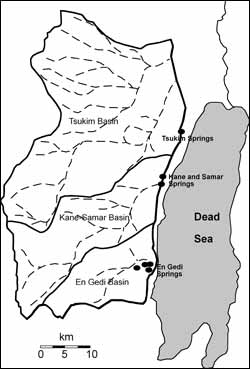There’s Water Under the Desert – But It’s Hardly Being Used

Illustration shows area covered by Judea Group Aquifer, with outlets into Dead Sea springs
The one place in water-short Israel where natural groundwater is available and not being fully exploited is – of all places – in the mostly uninhabited Judean desert.
This surprising conclusion arises from a thorough hydrological mapping study done as an M.Sc. thesis at the Hebrew University of Jerusalem by Leehee Laronne Ben-Itzhak, under the supervision of Prof. Haim Gvirtzman of the university’s Institute of Earth Sciences. The study provides detailed information regarding the nature, volume and path of what is called the Judea Group Aquifer, an underground water reservoir beneath the Judean desert. A report on the study was carried in a recent issue of the Journal of Hydrology
This aquifer begins in the Judean mountains and flows in a generally northeasterly direction towards the Dead Sea, with outflows at four springs adjacent to the Dead Sea – the Tsukim, Kane, Samar and Ein-Gedi springs. There is also some sub-surface flow into the Dead Sea.
The rain-fed aquifer contains an average yearly volume of some 100 million cubic meters of water, of which only about 20 percent is currently used, said Prof. Gvirtzman, with the rest flowing into the Dead Sea. The water potential of the Judea Group Aquifer is sufficient to supply 5 percent of the current total freshwater usage in Israel, said Gvirtzman, and could at least meet the potable water needs of the towns of Maale Adumim, Bethlehem and Hebron at much lower cost than at present.
Currently, he says the water coming to Maale Adumim is brought sometimes hundreds of kilometers from Lake Kinneret via the National Water Carrier. Why do that when there is water literally beneath the town? asks Gvirtzman.
In addition to the mapping survey carried out by Ben-Itzhak, who is now working on her Ph.D. theses at the Weizmann Institute of Science, another study is currently being done by a second graduate student, Eldad Levi, also working under Prof. Gvirtzman, who is analyzing the interface between the fresh and saline groundwaters at various points in the Judea Group Aquifer, using a novel remote sensing technique called the deep time-domain electro-magnetic method.
“These two studies have practical implications regarding future possibilities of groundwater development for the benefit of both Israelis and Palestinians residing in the area and for conservation of nature reserves located along the Dead Sea,” says Gvirtzman. “The government has allocated these waters to the Palestinians, who are unfortunately doing nothing to fully exploit this available water source,” he added.
As for the impact of drawing more water away from flowing into the Dead Sea, which is rapidly becoming depleted, Gvirtzman says that in any case the current groundwater flow into the Dead Sea is totally inadequate to halt that problem and that dramatic steps would have to be taken to resolve the situation.
The study of the Judea Group Aquifer was conducted with the support of grants from the Ring Research Fund at the Hebrew University and from the Israel Ministry of Environmental Quality.
Media Contact
More Information:
http://www.huji.ac.ilAll latest news from the category: Earth Sciences
Earth Sciences (also referred to as Geosciences), which deals with basic issues surrounding our planet, plays a vital role in the area of energy and raw materials supply.
Earth Sciences comprises subjects such as geology, geography, geological informatics, paleontology, mineralogy, petrography, crystallography, geophysics, geodesy, glaciology, cartography, photogrammetry, meteorology and seismology, early-warning systems, earthquake research and polar research.
Newest articles

First-of-its-kind study uses remote sensing to monitor plastic debris in rivers and lakes
Remote sensing creates a cost-effective solution to monitoring plastic pollution. A first-of-its-kind study from researchers at the University of Minnesota Twin Cities shows how remote sensing can help monitor and…

Laser-based artificial neuron mimics nerve cell functions at lightning speed
With a processing speed a billion times faster than nature, chip-based laser neuron could help advance AI tasks such as pattern recognition and sequence prediction. Researchers have developed a laser-based…

Optimising the processing of plastic waste
Just one look in the yellow bin reveals a colourful jumble of different types of plastic. However, the purer and more uniform plastic waste is, the easier it is to…



